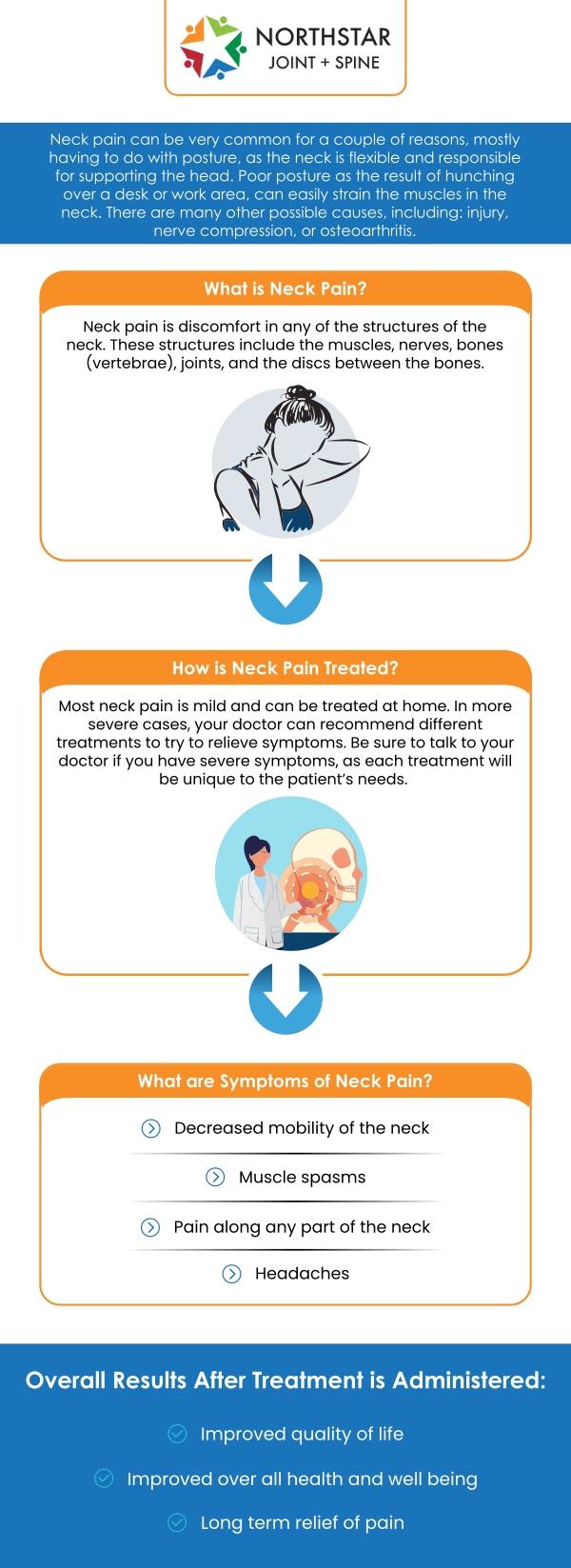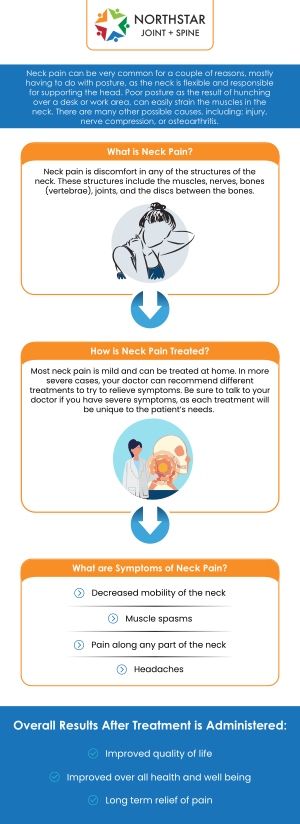Symptoms and Causes of Neck Pain in Plano, TX
Neck pain can result from poor posture, muscle strain, herniated discs, or arthritis, causing stiffness, headaches, and difficulty moving. Stress can also contribute by causing muscle tension. Symptoms may include pain, numbness, tingling, or weakness in the neck, shoulders, or arms. Left untreated, it may interfere with daily activities. Seeking treatment can help alleviate discomfort and prevent complications. Dr. Robert Nocerini, MD, and the team offer personalized treatments to relieve neck pain and restore your mobility at Northstar Joint and Spine. For more information, please contact us today or schedule an appointment online. We are conveniently located at 7704 San Jacinto Pl Suite #200 Plano, TX 75024.


Table of Contents:
Which conditions cause neck pain?
What are the common symptoms of neck pain?
How is neck pain treated?
How long does neck pain take to heal?
Neck pain can be caused by a variety of conditions that affect the cervical spine, which includes the bones, muscles, ligaments, and nerves of the neck. One of the most common causes of neck pain is muscle strain, often due to poor posture or overuse. These types of strains can lead to discomfort and stiffness, but typically improve with rest and conservative treatments.
Chronic conditions such as arthritis, and degenerative disc disease, can also lead to persistent neck pain. Osteoarthritis causes the cartilage between the joints in the neck to wear down, resulting in pain, swelling, and limited movement. Degenerative disc disease occurs when the intervertebral discs in the neck lose their cushioning ability, leading to discomfort and stiffness.
Spinal stenosis, which is the narrowing of the spaces in the spine, can also contribute to neck pain. This condition may put pressure on the nerves, leading to pain, numbness, or weakness in the neck and arms. Inflammatory diseases like rheumatoid arthritis can cause joint inflammation and stiffness in the neck, contributing to ongoing discomfort.
More complex conditions, such as cervical radiculopathy (nerve root compression) and herniated discs, may lead to severe pain due to pressure on the nerves in the cervical spine. These conditions may require more extensive treatment.
With so many potential causes, it’s important to consult with a healthcare provider to get an accurate diagnosis and the most effective treatment plan for neck pain.
Neck pain is capable of presenting in various ways, with a range of symptoms depending on its cause and severity. Common symptoms include localized pain or tenderness, often accompanied by stiffness that limits the neck’s range of motion. Stiffness can make even simple activities uncomfortable or difficult. Radiating pain that extends beyond the neck into areas such as the shoulders, arms, or upper back is another frequent complaint, particularly when nerve compression is involved. Some individuals may also experience headaches resulting from neck strain or accompanying tension.
Feelings of tingling, numbness, or weakness in different areas, including the arms and hands, may occur, particularly when nerves are affected by neck pain. Muscle spasms and persistent fatigue in the neck muscles are also typical, especially after prolonged activity or poor posture. Additional symptoms, such as dizziness or difficulty maintaining balance, may occur depending on the nature of the condition. Proper assessment and treatment are important to manage or resolve these symptoms, prevent further complications, and improve quality of life.
A number of factors influence how neck pain is treated, including the underlying cause, severity, and duration, as well as individual health factors and preferences. For acute or mild cases, conservative approaches such as rest, gentle stretching, and the application of ice or heat are often effective. Over-the-counter pain relievers may be recommended to reduce discomfort and inflammation. Physical therapy may be utilized as a standalone or complementary treatment, with tailored exercises designed to improve mobility, strengthen muscles, and correct posture.
For those experiencing more persistent or severe pain, minimally invasive interventions like corticosteroid injections may be used to target inflammation and provide relief. Chronic or complex cases may require the use of more advanced therapies, including specialized physical rehabilitation, prescription medications, or, in some instances, surgical options to address structural abnormalities. Additionally, complementary treatments such as massage therapy may be incorporated as needed to enhance relaxation and reduce muscle tension. A multidisciplinary approach ensures that care is customized to the individual’s needs, promoting both recovery and long-term spine health.
The healing time for neck pain can vary depending on the underlying cause, severity, and individual health factors. For minor conditions such as muscle strain or mild stiffness, recovery often occurs within a few days to a few weeks with conservative treatments like rest, stretching, and over-the-counter pain relief. More chronic or degenerative conditions, however, may require several weeks or months of treatment, including physical therapy or other targeted interventions, for full recovery.
At Northstar Joint and Spine, specialists create tailored care plans to address both acute and chronic neck pain, helping to expedite recovery. Chronic neck pain may require ongoing management rather than a specific recovery timeline. The recovery process can be influenced by factors like adherence to treatment, lifestyle changes, and overall health. Seeking timely medical attention from pain management specialists can accelerate the healing process, allowing many patients to regain comfort and return to their daily activities.
Neck pain treatment is available at Northstar Joint and Spine. For more information, please contact us today or schedule an appointment online. We are conveniently located at 7704 San Jacinto Pl Suite #200 Plano, TX 75024. We serve patients from Plano TX, Willow Bend TX, Frisco TX, Allen TX, Addison TX, North Dallas TX, and surrounding areas.

Additional Services You May Need
▸ Back Pain
▸ Chronic Pain
▸ Epidural Steroid Injections
▸ Spinal Cord Stimulation
▸ Viscosupplementation
▸ Genicular Nerve Blocks
▸ Facet Injections
▸ Joint Injections
▸ Sacroiliac Joint Injections
▸ Lumbar and Cervical
▸ Facet Medial Branch Blocks
▸ Diagnostic Nerve Blocks
▸ Medication Management
▸ Neck Pain Doctor
▸ Diabetic Peripheral Neuropathy
▸ Headaches
▸ Suboxone
▸ Botox for Migraines
▸ Peripheral Nerve Stimulation

Additional Services You May Need
▸ Back Pain
▸ Chronic Pain
▸ Epidural Steroid Injections
▸ Spinal Cord Stimulation
▸ Viscosupplementation
▸ Genicular Nerve Blocks
▸ Facet Injections
▸ Joint Injections
▸ Sacroiliac Joint Injections
▸ Lumbar and Cervical
▸ Facet Medial Branch Blocks
▸ Diagnostic Nerve Blocks
▸ Medication Management
▸ Neck Pain Doctor
▸ Diabetic Peripheral Neuropathy
▸ Headaches
▸ Suboxone
▸ Botox for Migraines
▸ Peripheral Nerve Stimulation






